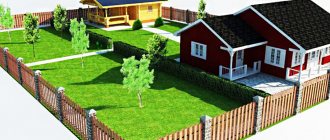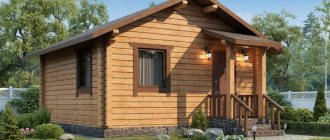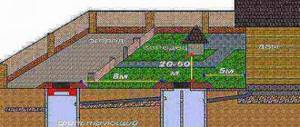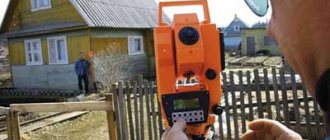On a plot of land, all buildings must be located at a certain distance in order to minimize the risk of fire and not disturb neighbors with shading and noise. If a landowner violates these requirements during construction, then he may have serious problems not only with neighboring land owners, but also with inspection authorities.
What to pay attention to when building a house?
The minimum distance from a residential building (individual housing construction) to the next site is provided for by law and cannot be violated. You need to know this before you order a house project. Otherwise, there is a high risk of a fire quickly spreading from one building to another, from which the entire dacha or cottage community will suffer.
It is best to initially divide the site into residential and commercial areas and provide all the required distances between the buildings and the neighbors’ site.
Compliance with minimum distance requirements affects not only safety, but also comfortable living.
If we are talking about an adjacent territory, then blocking buildings for economic needs is possible, but only with the mutual consent of the neighbors.
Distance from the septic tank to the fence: at what distance to place it from neighbors
The distance from the septic tank to the neighbor’s fence is one of the main requirements of SNiP and SanPiN, which is most often monitored by both neighbors and supervisory authorities. This topic is relevant for those who are forced to solve the problem of a missing central sewerage system when building a country house, an individual residential building in the private sector, or a country cottage. The standard distance from the fence or house to the septic tank is aimed at ensuring the safety of the health of others. According to existing sanitary standards, the use of even a purchased sealed container for liquid waste, which has a biological treatment function, is not a full-fledged treatment facility and requires compliance with certain restrictions.
Construction at the dacha
What is meant by the term "septic tank"
A septic tank is a special structure provided on a suburban area or private land in the absence of a centralized sewerage system, that is, a cesspool for sewage. Not a single type of housing construction can do without septic tanks, regardless of whether people live there permanently, come on weekends or during certain seasons. The function of a standard sedimentation tank is to accumulate sewage and prevent it from penetrating into the ground.
Improper arrangement of a septic tank leads to the spread of infection or contamination in the soil, the appearance of a specific aroma and the breeding of insects. This naturally raises concerns among neighbors, as well as careful monitoring of compliance with the norm of distance to the neighbor’s fence and distance from the house.
Buying a ready-made device is expensive, and it does not always give the expected results. Advertised products, especially those purchased at a promotion or at a discount on the construction market, may also not correspond to the laudatory description received upon purchase.
Design options
For seasonal or rare periodic use, sealed containers can be used to prevent soil contamination, however, if you live in a house permanently, more substantial structures are required:
- a filtration-type cesspool, the design of which involves the absorption of liquid into the soil, where it should hypothetically be processed by bacteria,
- a small single-chamber septic tank with an overflow pipe (with low quality cleaning of the flowing waste liquid,
- small 2-chamber - a design popular among folk craftsmen, quite simple to construct, consisting of two chambers united by a transfusion system,
- a multi-chamber septic tank, with the help of which the output is a safe liquid suitable for disposal into the ground, is very expensive, so it is quite rare among summer residents and even owners of country cottages.
Close to home and toilet
It is not surprising that every landowner is concerned about the location of his neighbor’s septic tank, because not only his comfort and health safety, but also the sanitary condition of the land plot depends on how far from his house and fence the septic tank or cesspool is located.
A sufficient distance from the house guarantees the absence of insects, infections and specific odors, and distance from the fence guarantees the safe cultivation of fruits and vegetables that will later be eaten.
It is the distance from the septic tank that is most often the subject of squabbles and litigation that arise if the distance seems insufficient to neighbors and constitutes significant inconvenience in the future or in real time.
Sometimes people build cesspools on their property as they see fit, without particularly caring about the comfort of those living behind the fence, their feelings and the inconvenience they experience. However, this is an illegal act because it does not comply with SNiP, which sets out in detail the necessary standards for construction carried out on private land ownership.
Code of Practice
SNiP or a set of norms and rules (SP), developed back in the era of mandatory state standardization, is a collection of regulatory recommendations, the data of which is still relevant in any construction. The use of SNiP by construction organizations, firms, or individual developers ensures compliance with fire safety and sanitary standards and ensures the safety of residence for those who will live in the constructed structure. SNiP is not a legislative document for individual housing construction or SNT, but it is the one that is most often used in resolving disputes between developers during legal proceedings.
The use of SNiP is also relevant when planning the proposed infrastructure on land ownership; this allows one to avoid difficulties when approving the plan-scheme in local authorities dealing with development issues. Its compliance is also checked by organizations that monitor compliance with sanitary and hygienic standards and fire safety rules, and monitor violations in the environmental sphere.
Structural layout according to SNiP standards
The basic rules governing the construction of a septic tank are distances from the fence and from the neighbors’ house. They are checked more strictly than all other indentations.
On your own land
Even on his individual housing construction site, the developer is obliged to comply with all the necessary standards in order to avoid administrative liability for violation of sanitary and hygienic requirements. Such construction is regulated simultaneously by construction and sanitary standards, and there may be certain discrepancies between them, which also need to be taken into account, for example:
- The recommended distance from a residential building to the septic tank is at least 5 m to the foundation, this allows you not to feel negative odors from the sewerage (of course, if it is in full working order). A standard of 5 m is established for a filter well, and a sump is sometimes built closer. The distance from the foundation is provided because of the danger of it being washed away if water for some reason begins to come out of the sump. Too large a distance and failure to maintain the required slope of the pipeline will create difficulties in case of blockage.
- The required distance of 5 m can be neglected, but only on the condition that the sewer system is equipped in accordance with the latest technologies and wastewater treatment is carried out locally and efficiently. Sometimes such structures are installed directly under the house in order to save space, if the owners have enough money to purchase a purification system that meets the requirements of the sanitation authorities.
- To a source of drinking water, the required distance from the septic tank is at least 50 m, and from the road - more than 5 m.
- There cannot be less than 4 m between the nearest tree and the septic tank; there can be more than a meter between the bushes.
- Environmental requirements are to maintain a distance to the nearest reservoir of more than 15 m, as well as to a river or stream.
- The sewerage system should be located at a distance of no closer than 30 m to the water intake point, provided that it is located upstream, but if the soil is sandy, it cannot be less than 50 m.
What regulatory documents, SNiP, GOST regulate the issue?
The issue of the minimum distance between sites is regulated by a variety of regulations. For example, the Urban Planning Code, which regulates the preparation of a development plan, the Land Use and Development Rules, SNiP and GOST, which sets requirements for the quality of concrete and other structures.
The minimum setbacks are indicated on the drawing of the urban planning plan of the land plot and they must be observed during construction.
What you need to know before construction begins:
- Town Planning Code of the Russian Federation;
- for a low-rise building: SP 30-102-99 (clauses 5.3.2, 5.3.4, 5.3.8);
- for country houses, outbuildings and other buildings: SNiP 30-02-97, SP 42.13330.2011, SP 53.13330.2011:
- Charter of SNT (if we are talking about a dacha).
The minimum distance footage is determined in accordance with lighting standards and fire safety requirements. The city has its own red building line, which must be adhered to.
Violating the established standards is only possible if the site has uneven terrain , for example, lowlands and hills, and compliance with the requirement is in principle impossible. If a bathhouse is being built in a residential building, then the requirements may also be violated, but first you need to obtain official permission to build such a facility.
GOST establishes requirements for the quality of materials from which buildings are made (from wood to concrete, cement), pipes, floors and other important construction details. These norms also cannot be violated, otherwise this could lead to the collapse of buildings and possible death of people.
Placement of a residential building
The main factors influencing the distance to the fence during the construction of a residential building are not so much the distance from the fence itself, but the buildings of neighbors and the fire safety of materials. However, there are other norms that inexperienced builders ignore when calculating for themselves the minimum permissible distance of a meter from the fence.
Distance to the road according to 2021 standards
It only works in relation to empty plots nearby, on which nothing has yet been built. A residential building must be at least 3 m away from the fence, and this distance is measured between the foundation, and not protruding parts such as a veranda, balcony or roof canopy.
Standards determining the distance from the house to neighboring buildings
If you plan to build a low-rise private house (1-2 floors), then according to regulatory requirements it must be built at a distance from the street of at least 5 m, and from the red line of passages - at least 3 m.
From sheds, garages and other buildings should also be at least five meters from the street.
Setback from the site boundary during construction:
- to the house (individual housing construction) - at least 3 meters from the neighboring plot;
- to the poultry house, barn - at least 4 meters;
- to the location of the bathhouse, garage and other buildings - at least 1 meter.
The distance from the windows of one house to the walls of a neighboring house and its garages and other buildings must be at least 6 m . Even the distance to trees (at least 4 m) and bushes (at least a meter) is regulated.
When building a country house at home, you need to take into account that sanitary conditions require that the neighbors be at least three meters away. From the barn or poultry house to the neighboring plot there must be at least four meters. From other buildings - at least a meter.
As you can see, the requirements for the minimum distance for country houses, garden houses and low-rise buildings built outside the city are almost identical. Exceptions are wooden houses, which are more susceptible to fires. For them, the so-called fire gap must be at least 15 meters.
Permissible distance from a garage, bathhouse, outbuilding, toilet, septic tank, cesspool to other building objects
When developing a site, not only a house is built, but also many other buildings. The distance from them to the neighbors’ living quarters must be at least 6 meters.
If the sewerage system has not yet been connected and a temporary toilet has been installed, then the distance to the walls of the neighbors’ house should be at least 12 m, and to the pump or well - at least 25 meters.
A toilet can only be connected to a central sewerage system or in the form of a cesspool, composted waste disposal (creation of powder closets, dry closets). Cesspools must be well insulated. For wastewater, filter trenches with a layer of gravel and sand are made on the site.
The distance between the column and the composter must be at least 8 meters. A minimum of 12 meters is required between the house, cellar and toilet, and showers, baths, saunas should not be placed closer than 8 meters. If the size of the plot itself does not imply such large distances, then no exceptions are made anyway. However, as practice shows, up to 95% of summer residents and owners of country real estate violate construction standards.
How are acceptable segments measured?
You need to measure the distance to your neighbors correctly: from the base or wall of the house to the neighbor’s fence. For protruding elements, for example, a porch or canopy, you need to measure from the protruding parts (if the protrusion is more than 50 cm).
The minimum distances to the border of the neighboring plot, as well as the distance from the road to the border of the land plot, are measured with a special measuring tape or rangefinder.
Distance from the septic tank to the fence: what to do according to SNiP and SanPiN standards
When owners receive land plots, they dispose of them differently, but a long stay on their land requires the construction of a temporary or permanent toilet. To avoid any troubles with neighbors, you need to know exactly and observe the distance from the septic tank to the neighbor’s fence, specified in the SNiP and SanPiN standards. Waste can harm the fertility of nearby land and natural water bodies. It is most convenient to choose the location for the septic tank when designing the site development. Then there will be no problems associated with violating the distance from the neighbors’ fence.
Regulatory documents and contradictions in them
When planning the site, the distance from the fence to the septic tank should be chosen according to the requirements of sanitary standards. They are collected in the SP - a set of rules - for each individual case. There is no single regulatory document that will answer the question of what should be the distance from the septic tank to the border of the site and the nearby well.
Some standards provide for distance from the water supply system, others set standards for the construction of sewerage systems.
SNiP contains building standards, but they may differ from the distances specified in the sanitary rules. Specialists from the SES are primarily concerned with the state of the environment and the location of the septic tank, bathhouse or latrine on the site.
Therefore, if they do not coincide, the figures for the distance of the toilet from the neighbor’s fence and the house are always greater. The fire department bases its requirements on the risk of fire and fire spread. Their standards are developed on the basis of fire safety and fire resistance of wall materials.
Basic sets of rules
SP 32.13330.2012 “Sewerage. External networks and structures.” It mainly regulates the distance to the septic tank from the house based on the layout of external sewer pipes, their length and slope. Septic tanks are not divided by type. The standards for VOCs and biological treatment plants are not specified at all.
SP 31.13330.2012 “Water supply. External networks and structures.” The document regulates only the standards for the removal of cesspools and sedimentation basins from water pipelines and other water supply facilities, without dividing them into types.
Similarly, there are standards for the creation of wells, gas pipelines, electrical and other air networks.
Norms of a legislative nature for individual housing construction sites in rural areas and on the territory of SNT are considered recommendations and are not mandatory. On the other hand, in disputes between neighbors, judges rely on them when making a decision.
For development in rural areas and on land with non-commercial use, SanPiN 2.1.5.980-00 “Hygienic requirements for the protection of surface waters” should be taken into account. They indicate sanitary standards for reservoirs, rivers, forests and meadows.
Requirements for different types of septic tanks
The distance from the septic tank to the fence depends on the type of septic tank itself, the status of the settlement and the presence of a neighbor behind the fence. In the updated versions of SanPiN and SNiP, the standards are specified only in the case of a built-up area of neighbors. Cases where there is no plot on the side or it is empty are not mentioned in the documents.
Distances from the site boundary depending on the type of septic tank
By law, a septic tank is a sealed container for collecting waste. If concrete rings or tires are placed in the pit, then they must have a layer of sand and fine gravel underneath them at least 40 cm thick - 20 cm of each filter material.
The owner is required to provide the SES with a plan diagram to obtain a building permit. The depth should be from 2 m. Experts determine more accurately, depending on the type of soil and the depth of clay and hard rock.
Rings or slopes must be coated at the joints with sealant or other material that will prevent waste from flowing out into the soil. If there is no tightness, there is no filter pad, then the distance from the septic tank to the neighbor’s fence should be 4 m according to cesspool standards.
A deep cleaning sump, like a closed two-chamber sump, poses a much lower risk of infection to nature and the soil. They can be installed from the side fence at a distance of 2 m.
A sump tank, consisting of sealed containers in which water is purified biologically or otherwise and periodically pumped out by machine, can be installed at a minimum distance from the neighbor’s fence - 1 m for individual housing construction sites and private houses in rural settlements.
On the territory of DNT or SNT, it is determined differently at what distance from the fence the septic tank should be located. For all types, except cesspools, a distance of 2 m is determined. Some of the most common types of products for summer residents today are Tank, Tver and Topas.
If there is a lake nearby, then the minimum distance of the septic tank from it, regardless of its design and tightness, according to the new law is determined to be 50 m. From running water resources, rivers and streams, the distance should be 30 m.
For private household plots, SNiP defines separate standards. If there is a pond behind, the area is not fenced off on its side. The border is considered to be a lake.
The septic tank is installed at a distance of 8 m from the neighbor’s house. It is enough to step back 5 meters from your own home. The distance to the sump tank of 10 m is determined not from the nearest point of the foundation of the building, but from the entrance to your own residential building. The method of measuring distance from neighbors' homes has not changed. Measurements are taken from the foundation or projection of a balcony, loggia, terrace. The distance is determined to be more than 12 m.
Table of distancing from neighbors of other buildings on the site.
Responsibility for violation of construction rules
Administrative liability is provided for violation of development conditions. This means that at any time you can be fined up to 2 thousand rubles (Article 9.4 of the Administrative Code).
To do this, it is enough for the neighbors to contact the local architectural supervision authorities or the prosecutor's office.
The very first inspection will reveal violations, and the official will issue a resolution on an administrative fine. However, demolition of the building and even the fence is possible only by court decision.
If a house or garage is built on the border of a plot and, for example, blocks light or interferes with noise, then you also have the right to seek protection of your rights and demand the demolition of the building and compliance with development standards. You can be guided by Art. 304 of the Civil Code of the Russian Federation, according to which no one has the right to obstruct the legal owner in the use of his property.
You can appeal:
- illegally installed fence (too close or higher than 1.5 meters);
- violation of site boundaries, use of joint territory;
- unauthorized seizure of an adjacent plot or other plot;
- a bathhouse or furnace built at a dangerous distance;
- non-compliance with standards for the location of the poultry house, toilet and other objects;
- any violation of development requirements that disturbs neighbors.
Disputes between neighbors are not uncommon, especially when the plots are small and closely adjacent to each other.
Important: any legal process requires large expenses (for a lawyer, state fees, examination fees).
These expenses are not always justified, especially if your neighbors’ violation of building codes does not cause any problems for you. Therefore, before deciding on legal battles, try to resolve the conflict peacefully.
How to peacefully resolve a conflict?
To do this, you can try to rebuild the building, if possible, or at least reduce the risks.
For example, if neighbors are afraid that the bathhouse may cause a fire, then you can install fungus on the chimney or take other fire safety measures.
For buildings made of unprotected wood, the requirements for a distance of at least 15 m to the nearest house, and for wood with a fire-resistant coating - from 8 to 10 meters. By adding coverings, we can easily solve the problem of violation of standards, and besides, we do not quarrel with our neighbors. If we are talking about a dacha, then the SNT board can be involved in resolving the dispute, it is possible to create a conflict commission and jointly solve the problem.
Conflict resolution through court
If it is not possible to resolve the conflict peacefully, you will have to go to court or a magistrate (if the amount of the claim is no more than 50 thousand rubles). In the event that a lawsuit is filed against you, you need to prepare a response, eliminate obvious violations if possible, and present evidence of this in court.
In this way, it will be possible to avoid the decision to demolish the building, which will negate all construction costs. Even in the case when the decision has already been made, and it is not in favor of the norm violator, you can appeal it by preparing a cassation appeal and at least delay the demand for demolition for six months or a year.
If your neighbors interfere with you, then you will need to go to the district court (at the location of the defendant) with a negative claim in connection with the infringement of the rights to use the site for its intended purpose.
The claim will need to state the essence of the problem, indicate the exact address of the site (yours and the defendant neighbors), present a diagram of the location of the objects and confirm the distance from one building to the border with calculations (preferably made by an independent expert).
When your neighbors' failure to comply with building rules results in the loss of crops, a fire, or excessive noise levels, you have the right to demand compensation for damage. The application will need to be accompanied by a copy of the title documents for the plot so that the court can make sure that the plaintiff is the legal owner, as well as calculations of the amount of the claim. You will also need a general cadastral plan (if any), a boundary plan, photographs of adjacent plots and other documents.
Judicial practice with examples
The practice of litigation between neighbors is ambiguous.
According to some claims, the demolition of, for example, a fence was denied if it was not 1.5, but for example, 2 meters high. The reason for this decision was the lack of evidence that the plaintiff’s rights were violated precisely by the darkness caused by the erected fence. However, in the cassation court, the plaintiff still managed to achieve the demolition of the fence only 50 cm higher than required.
But let us emphasize: there is no clear connection between violations of norms and neighbors’ demands to eliminate violations. For violating building regulations, the landowner will simply be fined, but the fact that he is harming his neighbors still needs to be proven. The courts are in no hurry to satisfy claims for fabulous amounts of moral damage from such violations.
Just in case, if the landowner decides to sue, it is advisable to stock up on photographs of shading from a fence or other structure and other evidence of harm. For example, if drainage standards are violated and rainwater flows from the roofs of neighboring buildings onto your site, then you can present invoices for paving this area with tiles or an approximate estimate of the lost crop.
You can attach a geodetic ruler and a protocol from the gardening association confirming the violation to the photo. Forensic environmental assessments and testimony from witnesses (for example, other neighbors) may also be needed.
There is no statute of limitations for negative claims . You can go to court at any time when the owner learns that his rights have been violated.
Where to place outbuildings
Outbuildings are also located in relation to a residential building, but existing laws require the distance to the fence to be taken into account.
How much do you need to retreat from the fence when building a bathhouse?
A problematic building, the placement of which depends on several factors. It can be brought closer to the fence by a meter, but the distance from your own and neighboring houses is calculated according to the type of construction, the material of both distance parameters (wooden - maximum distance, concrete and stone - at least 7 m). The distance can be reduced by using high-quality equipment or gutters made in accordance with the standards.
Toilet
The placement of the toilet is variable. The house may have a central sewer system or a specially equipped septic tank. Distances are determined by the type of building - powder closet, birdhouse or backlash, but the source of drinking water must be removed from the toilet (at least 12 m).
Outdoor toilet
How many meters do you need to retreat to build a garage?
When building a house, distances from neighbors are necessary not only if the car hangar is located under the same roof as the home. The garage must be located at least 1 meter from the fence, provided that there are no windows of the house opposite the new building, into which airborne contaminants may enter.











